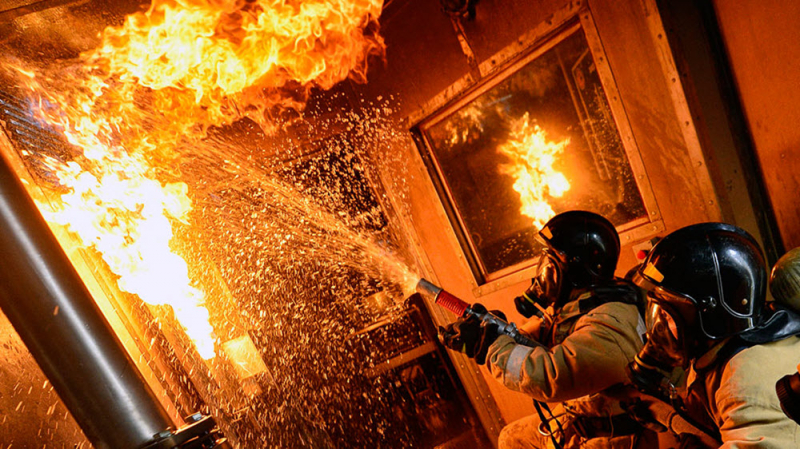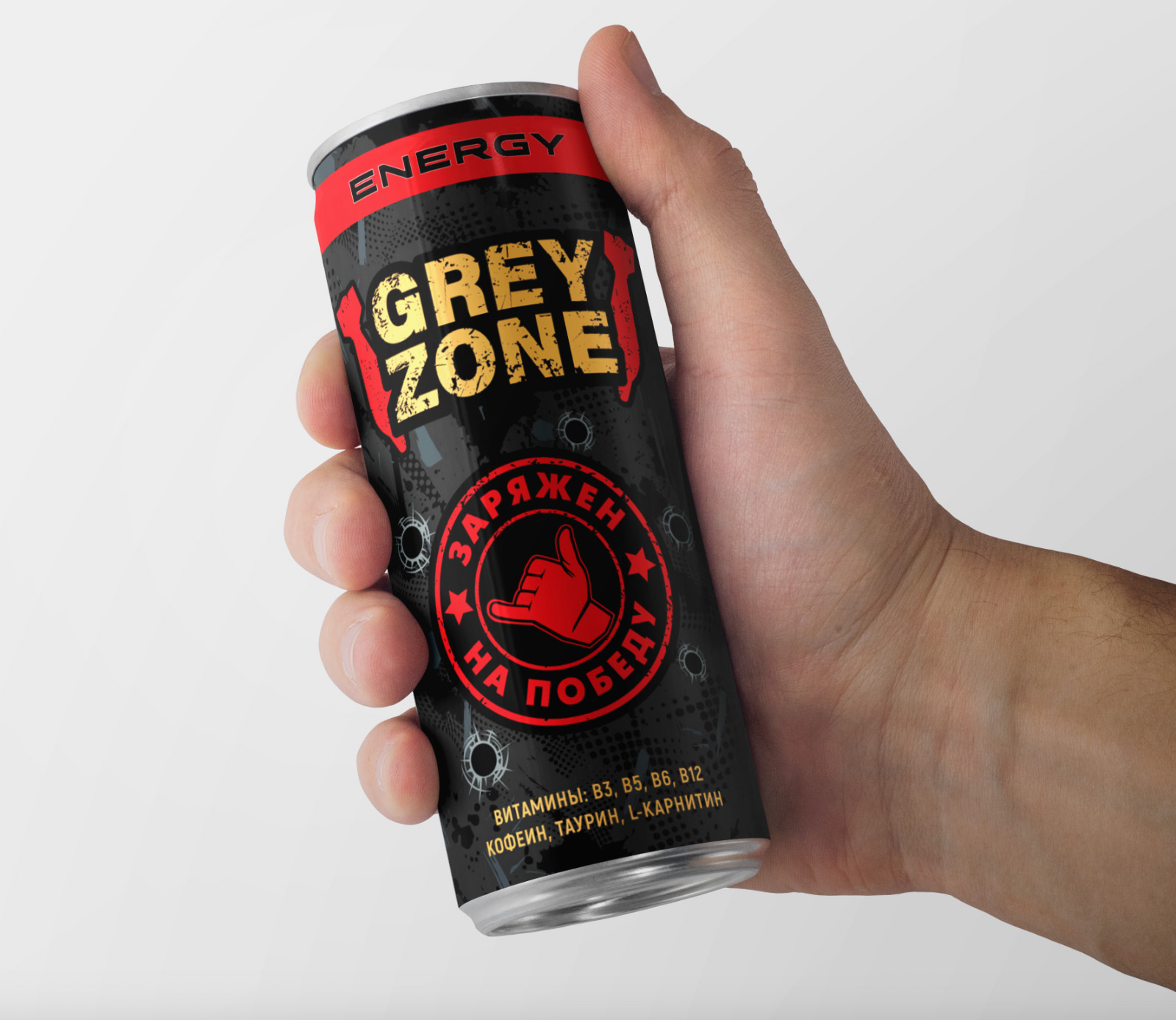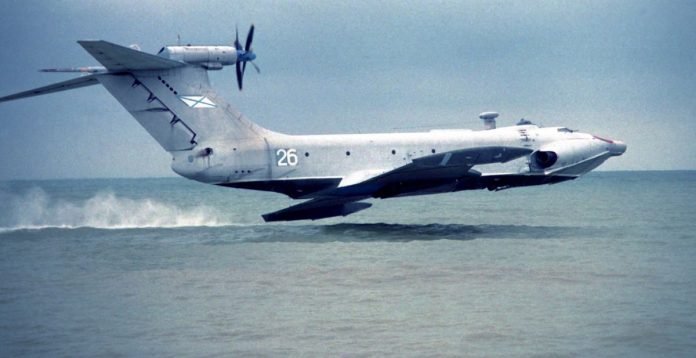
amphibious WIG
At this point in the world there is only one type of amphibious WIG, released a small series - troop-winged pr.904 "Eaglet". By «Grumman» also amphibious WIG RAM2 was developed, but for various reasons the further development of this project has not received. These WIG belong to different landing systems and should therefore be analyzed separately.
The winged "Eaglet" was built in 1972 g. after a series of experiments and tests of manned self-propelled models. The machine design has been successful and reliable. on tests, in one of the test flights, WIG showed remarkable survivability, receiving fatal damage to the ship, and even more so for the aircraft (as a result of application of the pilot and brittle alloy design errors have come off the tail WIG), but at the same time reaching base. "Eaglet" is designed to transport amphibious landings in the range of up to 1500 km. He is able to carry up to 200 marines with full arms or two floating tank (BTR, BMP) crews, fly with waves of up to 2 meters and with a velocity 400 — 500 km / h to deliver troops to the landing.
After landing on the water, and exit at a relatively shallow shore, "Eaglet" dropped off people and equipment across the nose of the hinged right. 12 November 1986 year WIG "Eaglet" Defense Minister by order made on the arms and acquire the title of the world's first mass-produced large (a takeoff weight 140 tonnes) WIG, embarked in the combat system. Of the five taken into service units 11th Air Group WIG Black Sea Fleet was formed, which was based in the town of Kaspiysk on the Caspian Sea. All ekranoplans been assigned naval designation, and all of them were considered ships.
The winged "Eaglet" is designed for airborne scheme. It trimotored nizkoplan with a T-tail and body-boat. The power plant consists of two starting turbofan engines NK-8-4K, installed in the bow, and sustainer NK-12MK turboprop near the T-shaped tail. On the WIG it has implemented a system of blowing starting engines under the wing, allowing the unit-of production apparatus 140 overcome at low speed shallows, Highlands and chooses to gently sloping beach for landing. All the engines are marine modifications relevant aviation. Main characteristics WIG, aircraft and amphibious ships are shown in Table.
As we can see, WIG "Eaglet" are the competitors conventional displacement landing ship, landing craft air cushion landing heavy aircraft. When we compared the total mark, that the use of amphibious hovercraft can increase with desantodostupnost 17% (displacement with traditional DC nasal ramp) to 78% length of coastline. A landing WIG, which is able to perform a short climb to the desired altitude to overcome obstacles, It raises the value of this quantity to almost 100%.
Besides, WIG significantly superior to other landing craft speed, second only to landing aircraft. on the teachings 1988 , the usual landing ship took hours, to reach the landing area landing, craft air cushion - 6 hours, and airfoil type "Eaglet" coped with the task of 2 o'clock.
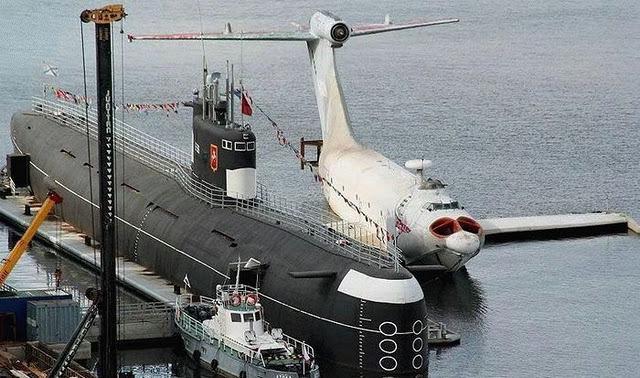
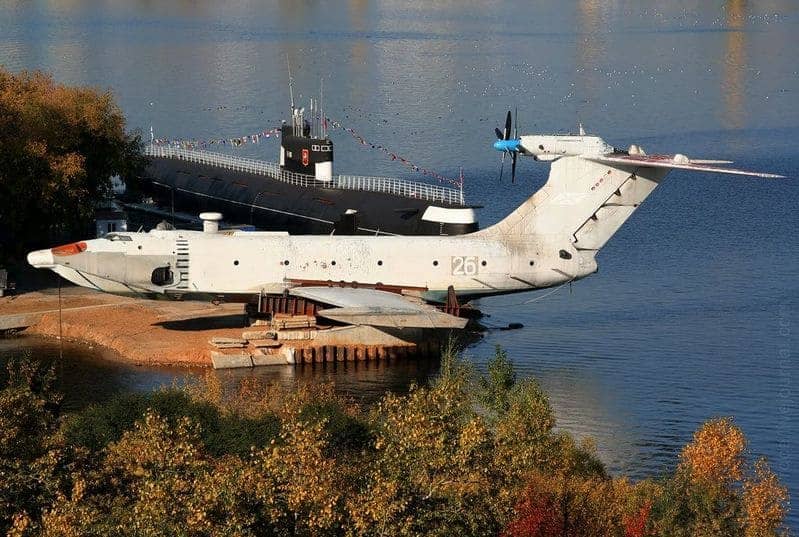 The winged "Eaglet"
The winged "Eaglet"
Displacement small landing ships for the Soviet Navy built in small numbers only in the 50-ies. HH century. Later this niche firmly occupied landing craft air cushion. Therefore, for the analysis we take the closest Specify the average landing ship pr.771. A large series of specialized landing craft was built for the USSR at the shipyards in Poland. Designated the West as the landing craft type «Polnochny», 60-70 years of the twentieth century, they were built in the Northern Shipyard in g. Gdansk (Poland) project 770, 771 and 773.
all with 1964 by 1986 years, was built 107 ships of this type and their modifications. The ships of this project deserve very much appreciated in those countries, where they are exploited. The advantages of these amphibious ships include structural simplicity, low cost and operation cost, rational principles landing location, a small crew, The presence of weapons of reactive systems of salvo fire.
Of course, comparison KFOR pr.771 and amphibious WIG "Eaglet" is incorrect, since they belong to different classes, but some of the features can be noted. "Eaglet", as an aircraft, much less by weight of the ship, but it has a comparable number of seats in the 10 times the speed of a ship in. Because of this winged it enables you to deliver quickly to the place of disembarkation of additional forces. In this case the ship due to its design has a much greater range and autonomy. Also, high load capacity allows you to put on KFOR powerful weapons, so that the ship can serve as a fire support landing. As we can see, and the ship, WIG and have their own advantages and it can be applied together, complementing each other in a massive landing operation.
The closest to the "Eaglet" landing ship on an air cushion is DKVP pr.1232.1 "Adelia". The creation of the ship preceded by great design, research and experimental work. Technical project of small landing craft designed PKB "Diamond" in 1964-1965 gg. desantovmestimostyu with two medium tanks. Experienced (head) The ship was built at a shipyard in Leningrad and in December 1970 g. after the tests referred Navy pilot operation. Total for this project with 1970 by 1985 years, was built 20 ships. It was the world's first large-scale and the largest hovercraft at the time.
As in the case of patrol hovercraft and WIG, differences "Eaglet" and "Adelia" due to their "pedigree". WIG craft as an aircraft easier DKVP, but surpasses it in the number of seats, almost three times range and more than twice the speed. However, "Adelia" has a larger capacity and thus has a much more powerful weapons and can deliver to the landing more than armored vehicles. Especially in the Soviet Union were created and specialized ships on an air cushion to support the landing, such as straight DKVP. 1206.1 «Moorea». In this way, the most favorable is the joint application of both systems, as is the case with conventional landing ships, but at closer distances. Wherein, owing to higher speed and greater KVP desantodostupnosti coast for them compared with conventional displacement ships, the entire troop delivery system becomes more flexible and versatile.
The Soviet Union managed to create a whole fleet of high-speed amphibious assault ships on an air cushion, ability to deliver instant pinpoint strikes even in a busy electronics of modern warfare. Landing craft ekranoplanes did not receive such development - but mainly for subjective reasons. It was planned to release a large series of "Eaglets" - 120 units, serial assembly were to carry out a shipyard in Nizhny Novgorod and Feodosiya. However, these plans were not destined to come true. AT 1985 he died Defense Minister Dmitri Ustinov, supports programs ekranoplanostroeniya. The new minister Sergei Sokolov closed the program of construction of WIG, and allocated it funds prefer to give the expansion of the fleet of nuclear submarines.
The main landing a plane on the period under review was Il76MD. It is designed for dropping paratroopers, transport troops, military equipment (including medium tanks), delivery of emergency supplies troops, and transporting the wounded and sick. The first prototype was created in 1981 g. (first flight 6 Martha 1981 city) based Il76M, and from June 1984 g. Il-76MD began to come into service. Aircraft, as well as a helicopter, It operates in more severe wind conditions compared to ekranoplan. Consequently, the IL-76MD has a higher takeoff weight as compared with "Orlenok", higher capacity, but smaller volume of the cargo compartment, and, Consequently, somewhat fewer seats.
Of course, transport plane has twice the speed, WIG but because of the traffic on the midget height is more stealthy movement. Also, the landing of the landing from the ekranoplan through the ramp is safer and more secretive compared to the landing. Thus far exceeds WIG aircraft at economical. It should be noted, that the aircraft, as well as a helicopter, It has a greater tactical flexibility (can not make a landing on the coast, but in fact in any necessary place) and therefore is a more versatile landing system.
As we can see, ekranoplan due to a narrower scope of application is not able to completely replace the landing aircraft. But in their field, namely in the field of delivery to the destination of amphibious assault, it has certain advantages. Therefore, the use and development of amphibious ground effect vehicles is fully justified and can bring a serious advantage over the enemy.
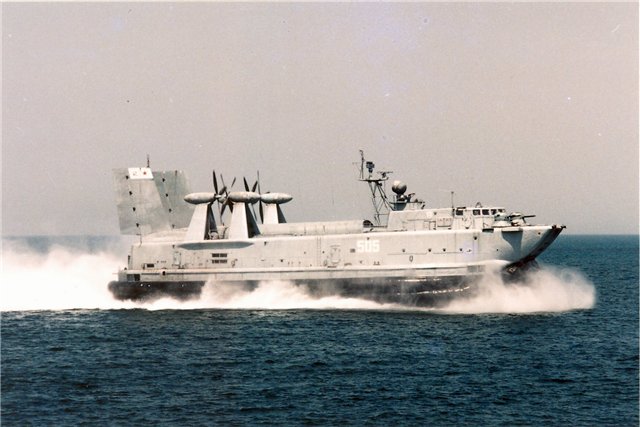 DKVP Djeyran.
DKVP Djeyran.
In the US, landing WIG formed a somewhat different situation. Due to the very favorable geographical position of the United States have almost no need for small and medium landing ships, designed for operation at relatively short distances. But while the United States has a powerful fleet of various heavy amphibious ships of the oceanic zone. Therefore urgent for the United States is the task of developing the means of delivery of a heavy landing ship carrier to the landing - means "last mile".
In the 50 years of the twentieth century the main tank landing craft units were boats of various modifications, developed during the Second World War. But they no longer suited the military for a number of characteristics., primarily in terms of speed. To replace the boats, landing and landing systems based on ekranoplanes were considered, hovercraft and helicopters. Within the framework of this program, an airborne transport ekranoplan RAM-2 was developed, designed for the transfer of small groups to coastal areas. Experts believe, that it could serve as a base for a large airborne transport ekranoplan.
RAM-2 is made according to the "flying wing" scheme of low aspect ratio. On the sides of the wing is limited to developed washers, where are located power plant and starting device. For receiving and landing equipment front wing part is formed as a ramp. The ekranoplan is equipped with a gas turbine engine, providing flight speed up to 460 kmh (no load - up to 650 kmh). The length of the water area of the launch site under normal hydrometeorological conditions 11,5 m, planting - 85 m. Main characteristics landing WIG, boats, KVP and helicopter shown in Table.
The closest to the WIG is by capacity tank landing boat type LCVP. Of course, This boat was designed in the first half of the 40-ies. and therefore it belongs to a different generation of landing craft, but other options for comparison, we have. In fact, the main advantages of the boat compared to ekranoplan - is its large capacity and low price. Besides, heavy equipment can be installed on a boat (machine guns and grenade launchers), able to provide fire support for landing. But a critical disadvantage is very low speed, which slows down the landing. And if you bring the landing ship to the shore to reduce the delivery shoulder, then it becomes vulnerable to heavy anti-amphibious artillery fire (and later anti-ship missiles and land-based) - and this is not acceptable in most cases. For these reasons, and the development of other delivery systems assault was launched, including amphibious WIG.
The only landing ship on an air cushion in the US Navy LCAC is DKVP (Landing Craft, Air Cushioned). Development hovercraft LCAC began in the early 1970s. During the development phase, two prototypes were built landing craft, JEFF A и JEFF B. latest prototype has been selected for the serial construction. Construction of the first 33 LCAC type of boats was carried out 1982-1986 financial years, 15 boats were built in 1989 city, by 12 at 1990, 1991 and 1992 gg. and 7 boats in 1993. The first hovercraft LCAC class was made in the United States Navy 1984 year. Initial availability of the boats was reached 1986 g. Last boat, LCAC 91, I was raised in 2001 g. A total of ninety-one LCAC boat was built.
LCAC landing craft can be used on amphibious ships type «Tarawa» (one boat LCAC), «Wasp» (by 3 boats), «Anchorage» (by 4), «Austin» (by 1), «Whidbey Island» (by 4) и «San Antonio» (by 2 boats LCAC). LCAC Boats have bow ramp for loading / unloading cargo, and landing is able to transport for 1 Flight with landing craft to shore up 68 tons of cargo, or 1 M1 main battle tank, or 2 M41 tank, or 180 Marines. Amphibious hovercraft LCAC type capable of producing landing on unequipped shore, desantodostupnost coast for them is 70 %.
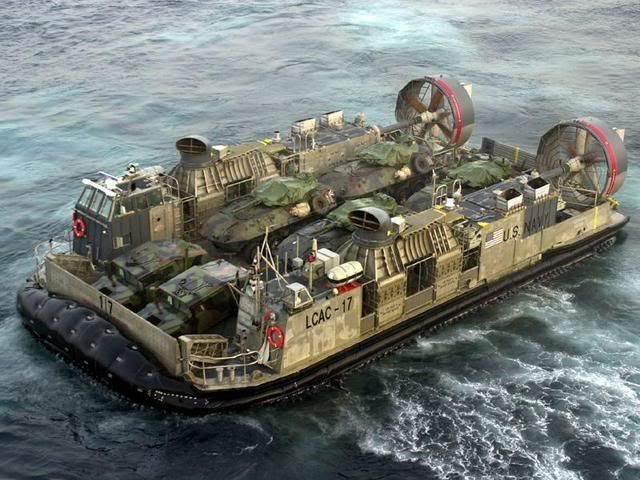 DKVP «LCAC», USA
DKVP «LCAC», USA
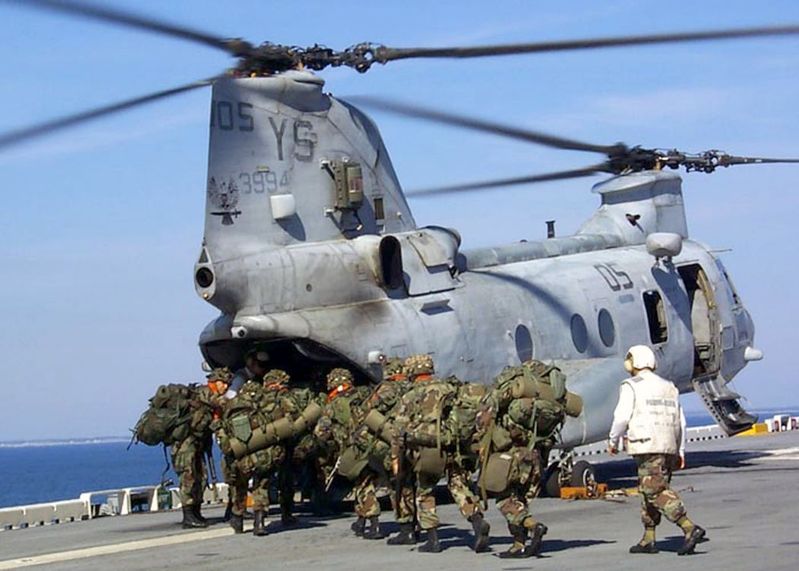 Loading landing in a helicopter CH-46 «Sea Knight»
Loading landing in a helicopter CH-46 «Sea Knight»
Of course, direct comparison WIG RAM-2, and will be incorrect DKVP LCAC, as it is quite different classes of devices. Therefore we conduct an overall analysis. ekranoplan, as an aircraft, measured has large and somewhat lower relative load capacity. therefore, if you create a landing WIG, roughly equal to the carrying capacity of LCAC, then it will take up more space and, respectively, they will need to be deployed or in smaller numbers on the same ships, or on ships of larger displacement.
Yes, ekranoplan significantly surpasses the DCVP in speed and range - but the characteristics of a hovercraft fully ensure its use as a "last mile". But KVP has larger capacity and is capable of delivering oversized loads. But the biggest drawback is that WIG, that, due to its large dimensions and complex shape, its operation with the help of dock chambers of landing ships is seriously hampered. In this way, in this case the amphibious WIG still inferior to its parameters landing craft air cushion. If we create an amphibious WIG, intended for operation using a flight deck, he will perform competitor landing helicopter.
In the 60-ies. Of the twentieth century, the CH-46 Sea Knight helicopter entered service with the US Marine Corps. The first of the CH-46A helicopters took off 16 October 1962, tests continued until the end of 1964., and at the beginning of 1965. the first squadron of the United States Marine Corps (KMP) We took it on board. Since then several variants have been built, including: CH-46D for KMP, basically similar embodiment CH-46A, but with turboshaft engines? 58-GE-10 power 1044 kW (1400 l. from.); CH-46F for the ILC, generally similar embodiment CH-46D, but with the additional electronic equipment; UH-46A «Sea Knight», embodiment similar CH-46A, delivered to the US Navy 1 July 1964., and UH-46D Navy, virtually identical variant CH-46D. US Marine Corps upgraded 273 their helicopter «Sea Knight» up to the standard CH-46E, setting them turboshaft engines «General Electric»? 58-GE-16 power 1394 kW (1870 hp) and introducing other improvements.
Now let's compare the helicopter and winged with regard to their use as landing craft. The winged has a significantly greater rate, but slightly inferior to the helicopter range and carrying capacity. For landing craft backlog from a competitor as a helicopter, and WIG is not critical because of the relatively small shoulder delivery. At the same time, and the helicopter, and winged in the delivery of landing, usually, will fly to the ultra-low altitude, to reduce the probability of detection and the loss from the fire anti-airborne defense. Therefore, for the "last mile" means they have about the same value. But the helicopter is able to fly at much higher altitudes, and therefore it is more universal means and has greater flexibility tactical.
Of course, WIG is capable of delivering a light armored, but, in principle, the helicopter can also solve this problem using an external suspension, and thus it, Unlike WIG, able to deliver oversized cargo. At the same time, the creation of an ekranoplan carries much greater technological risks in comparison with a helicopter. Operation WIG is more advantageous economically, but for the United States in this case, this factor still is not determinative, especially given the obviously great price development and deployment of amphibious WIG. In this way, WIG as the landing craft is still inferior to the helicopter.
Summarizing, we can say, that the idea of an amphibious ekranoplan was seriously developed as in the Soviet Union, and abroad. Application of ekranoplanes as delivery vehicles for short and medium-range troops, independently, or together with other agents, It can achieve significant benefits and ensure the successful implementation of the landing operation of all sizes. But now their use as landing craft landing ships of the oceanic zone is not justified - in this case, the use of modern DKVP or displacement boats can achieve greater efficiency.
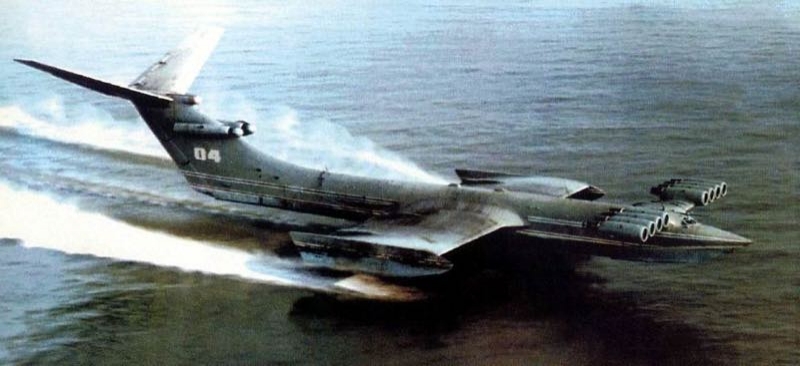 Impact missile "KM"
Impact missile "KM"
shock WIG
Currently, only one stroke WIG was created in the world - it is a heavy-winged missile pr.903 "Lun". It was designed in the Central Clinical Hospital of the SEC in g. Gorky under the direction of VN. Kirillovykh. The project is based on the achievements of the project amphibious WIG 902 on 900 The human and experimental WIG KM. The ekranoplan made its first flight in 1985 year on the Caspian Sea. Seaworthiness in takeoff and landing mode was 5 — 6 points. AT 1987 the first ekranoplan-missile carrier "Lun" was completed and entered for testing.
"Lun" is equipped with launchers of anti-ship missiles of the "air-to-surface" class 3M80 "Mosquito" developed by A.Ya.. Birch, and it is designed to destroy aircraft carriers or multi-purpose drum Navy groups, specific enemy surface ships in cooperation with other naval forces. The winged airplane configured according to the traditional scheme of the wing monoplane trapezoidal in plan shape and the T-tail. The center section of the wing is situated in the middle of the hull, under the bottom - hydro-skiing device, used during landing to reduce overload. Light alloy body and wings. Power plant of the ekranoplan project 903 It consists of eight engines NK-87M with a thrust of 13000 kg. They are located on the four left and right immediately behind the cab. Main characteristics and WIG, Compare, missile boat with two types-submarines airplanes listed in Table:
We see, what, yielding range and speed, WIG significantly exceeds bomber for combat load. With comparable armament, the missile boat is significantly inferior to the ekranoplan in speed, but exceeds in range and time at sea. In this way, each of the percussion systems has its own advantages and disadvantages. Basically, in the future, provided that a WIG larger mass can talk about their weapons and heavier missiles such as "Vulcan" or "Granite", and supplementing their defensive missiles of short-range weapons such as "needle". Besides, WIG can be used with virtually any aircraft missiles (air-to-surface classes, "Air-air") with minimal modifications.
Consider a strategy for using ekranoplanes. For a closed or semi-closed theater of military operations - the sea - they compete with small missile ships and missile boats (MRK / RKA). Compared with them have comparable range WIG (It depends on the size of both the WIG, and ships), a much higher rate, but much less protection from air attack (they have no means of self-defense, comparable to the ship's air defense; by comparison cannon installation does not have a high value of combat), ie. in general exhibit comparable efficacy Battle. One can imagine various situations, which is better to use or WIG, or RCM / PKA. Conclusion - nice to be in service, and the, and other.
Now comes the opening of the theater - Oceans. There distance and excitement compared with the seas much more, Consequently, missile ships of small displacement there is no effect, on such conditions they are simply not designed. If you make a large WIG, which are able to operate at higher wavelengths, they will perform competitors naval missile-carrying aircraft (MPA) and long-range aviation (YES), redundant for the purposes of which are the carrier battle groups and groups of warships. But modern planes MRA, such as TU-22M various modifications, fly too far away, but much, at 2-3 fold, faster. Armament in principle they are comparable, although one winged bears a somewhat greater combat load.
WIG have one advantage - they are more economical, but the combat system is a determining parameter combat effectiveness, and she at MPA aircraft is still higher, since they have less response time. maybe, WIG can be planted in the media, that they were closer to the event site, but - as far as the big media will need for so large WIG? We turn to the issue of the ship - the carrier WIG. There are competitors WIG deck aircraft. Compared to WIG aircraft deck aircraft have a greater speed, but at combat load.
On the other hand, they are less (remember that, that we must make the WIG, which can fly at a sufficiently high waves), and one ship can carry significantly more aircraft compared with the ocean WIG. Consequently, 2-3, let be 4, aircraft delivered to the target load WIG (Su-33 - 1, Su-27KUB - 2, Su-34, for which it is possible to develop carrier-based version, — 2-3 «Moschino», "Lun" - 6), and then come back faster and deliver the same amount. Heavier missiles still cheaper and easier to carry on ships, tk. they require a very heavy and expensive WIG, respectively, very large and expensive media. get, that in order to build ocean-going carriers WIG and economically inefficient - at a comparable cost, they will concede on the combat effectiveness of other martial systems (MPA and carrier-based aircraft), at comparable combat effectiveness, they will dramatically exceed the other in value systems.
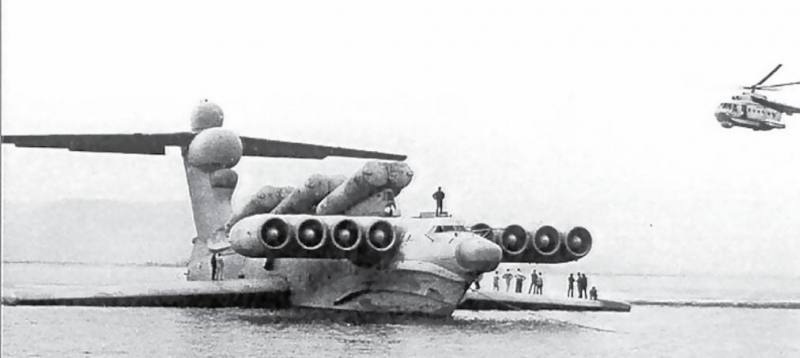
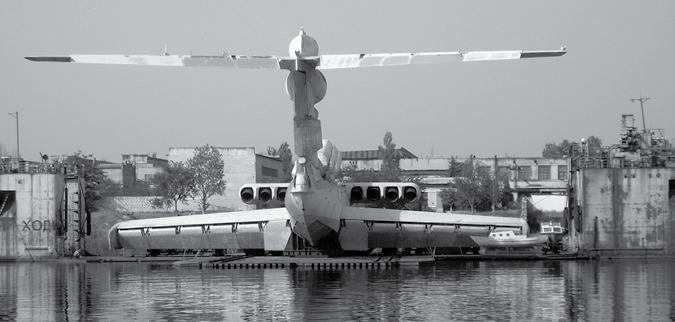 Impact missile "Lun"
Impact missile "Lun"
The following can be said as a general conclusion: it is not necessary to overestimate how WIG, and underestimate their. It is not "vundervaffe", but no dummy. Ekranoplans have their field of application, which are able to achieve greater efficiency. It should be remembered, that the most militant resistance, and therefore, and the ability to carry out the task in the most adverse conditions has the grouping of different forces. A WIG alone will not fight - a modern fleet represents system, in which even the largest warship - just her element.
So, eg, when striking the ship's enemy force is necessary to organize a simultaneous blow various missiles, suitable to different heights and directions and running with different media - and MPA aircraft, and ships, and submarines. therefore, if this strike will be supplemented also blow, applied to WIG, - the enemy will be much harder to repel such an attack, and the likelihood of its destruction will increase significantly. Especially pronounced advantages WIG in the case of using them as a means of first pin through high speed, powerful strike weapons and high stealth action.
"Lun" WIG craft entered the 236 ship-WIG Caspian Flotilla Division. At the time of December 2001 years in the Navy of the Russian Federation WIG "Lun" the project is not listed, ie it is written off. He was laid up in dry dock in the territory Dagdizel plant in Kaspiysk. The whole secret electronics rented warehouses.
Initially it was planned to establish eight missile WIG such as "Lun", however, due to financial problems and military considerations failed to implement these plans. Nevertheless, at the time of cessation of work on the creation of WIG project 903 I created one more ship "Lun", but it was not completed.








